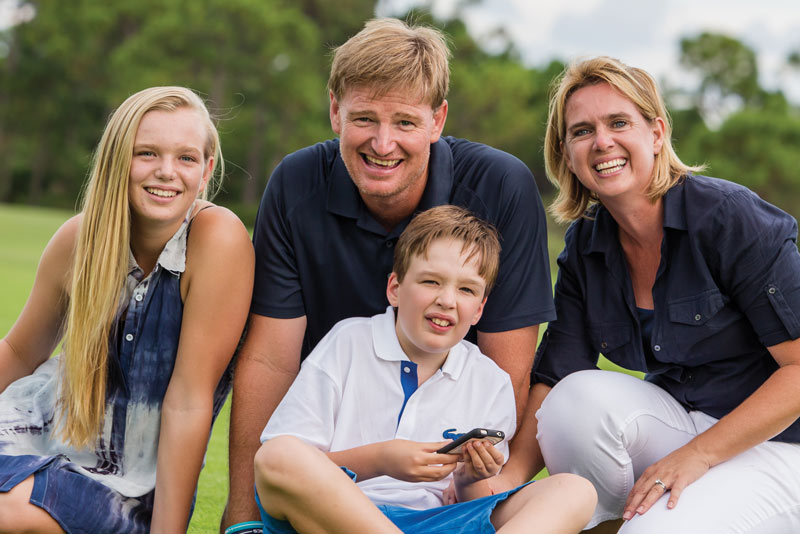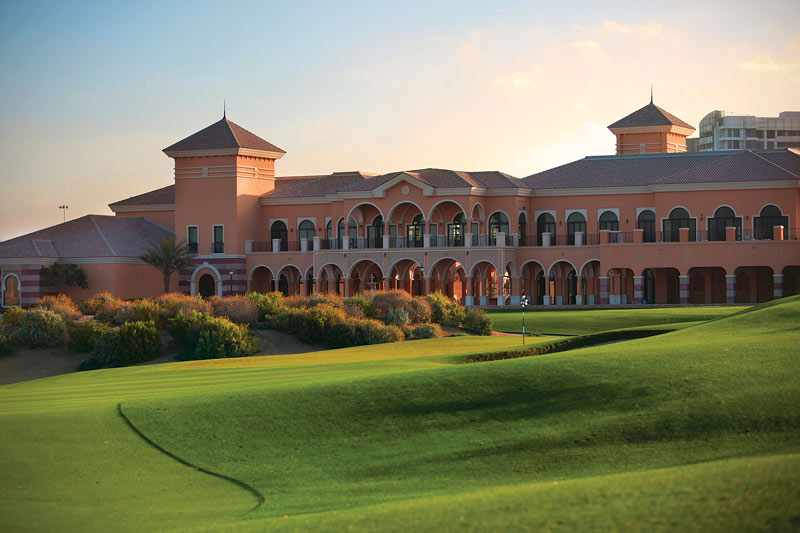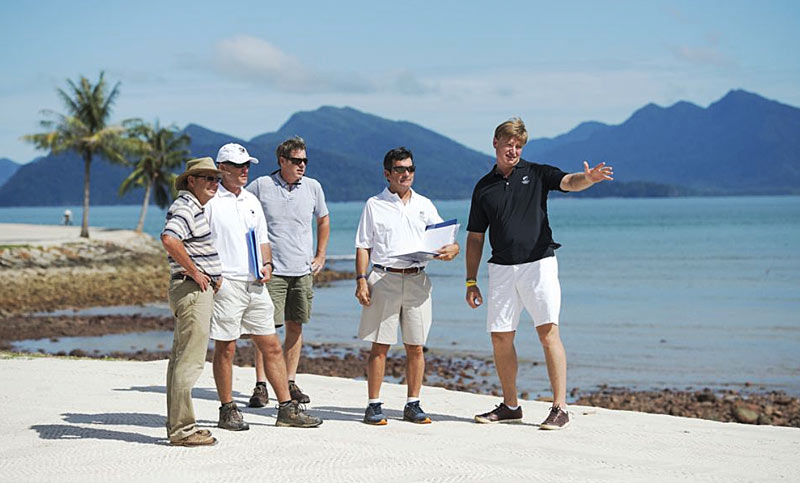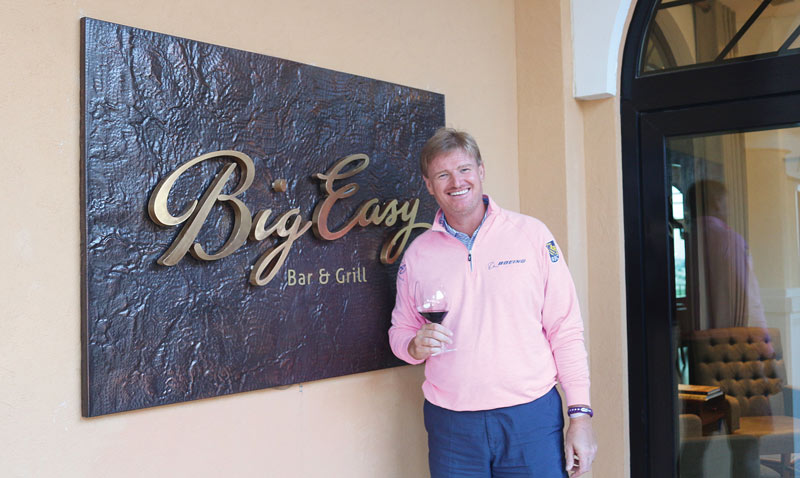
Ernie Els, the 2018 Old Tom Morris Award recipient, in the center of a family portrait with his wife, Liezl (right); daughter, Samantha (left); and son, Ben. Photos courtesy of The Els Group
Known as “The Big Easy” for his effortless-looking golf swing, Ernie Els is anything but effortless in his intentions.
It took effort to win four major golf championships. It took effort to launch the Els for Autism Foundation and build The Els Center of Excellence, which includes an educational facility aimed at providing a tailored learning environment and assisting families confronted by autism. It took effort to receive this year’s Heisman Humanitarian Award.
“Ernie always has had that something special about him,” says World Golf Hall of Famer Nick Price.
GCSAA recognized those qualities in Els, and selected him as the recipient of the 2018 Old Tom Morris Award, the association’s highest honor. Els will receive the award at the Golf Industry Show in San Antonio, during the Opening Night Celebration on Feb. 6, which is presented in partnership with Syngenta.
“I am honored and humbled,” says Els, 48, who was born in South Africa and stormed the U.S. as a 14-year-old, beating players such as Phil Mickelson on the way to a world junior championship in San Diego. He won the 1994 U.S. Open at Oakmont (Pa.) Country Club, one of more than 70 events in which Els has prevailed professionally (including two U.S. Opens and two British Opens). Els was a staple in the top 10 of the Official World Golf Ranking for a record 758 consecutive weeks, from June 1994 to January 2009. His journey has also been littered with honors beyond the fairways, including the 2015 Payne Stewart Award, which is presented annually by the PGA Tour to a person who best exemplifies the values of character, charity and sportsmanship.
GCM’s Q&A with Els, below, covers a lot of ground, from the importance of superintendents to his fellow tour pros picking him as the one guy to have their backs in a fight. He even dropped in a word that had us reaching for the dictionary (hint: niggles). Enjoy.
Q: What does it mean to you to receive the Old Tom Morris Award?
A: It’s a great honor, thank you. I guess you think of those photos of Old Tom and the impact he had on the game of golf back in the day. He was obviously a great player and he was one of that small group of top players who did a lot to grow the game when championship golf was really only just getting started. So, those guys, they got the ball rolling, so to speak.
Q: If you had the chance to meet Old Tom, what would you say to him?
A: I’d just want to see what it was like playing with those hickory-shafted clubs and old-style golf balls. And playing golf in a tweed jacket and tie! That was a whole different ballgame right there, but they still managed to shoot some decent scores. That’s incredible. I’d love to see how they did that.
Q: In terms of agronomy, what role does modern maintenance play in the game?
A: It’s huge. When you talk to golfers and they’re visiting a golf course, one of the first things they’ll mention is the condition of the course. Most tour pros are the same. It’s absolutely fundamental to the enjoyment of the game. As I’ve grown in my involvement with the game of golf, from professional golfer to golf course designer, I have come to value more and more the role of golf course superintendents. They are as vital to this game as ever, and as vital to this game as anyone.

The Els Club Dubai is among the golf courses that Els has designed. He applied features from courses worldwide, including designing greens that resemble those at Pinehurst No. 2.
Q: In what ways have golf courses improved based on maintenance practices?
A: As we’ve gained more knowledge and as equipment has become more efficient, it’s enabled clubs to do a better job of maintaining courses. So, I’d say the general standard of maintenance has improved across the board, but it’s an expensive business, and that’s definitely an issue. It’s something we’re very much conscious of at Ernie Els Design, and we’re always mindful of introducing design solutions that could have a positive long-term impact on the running costs at a golf club as well as the environment. Let’s face it — everyone works to a budget at some level. One example that springs to mind is at The Els Club Teluk Datai (in Malaysia), where we basically built a course in the middle of a rainforest, so you’ve got heavy levels of rainfall. As we all know, rain is the enemy of bunker maintenance, so we created a layout with no bunkers. It works on every level — aesthetic, strategic, environmental and practical.
Q: You have shown a passion for reaching out to those who have autism, particularly with the formation of The Els Center of Excellence in Jupiter, Fla. How rewarding has it been to help so many people, as well as to teach so many people about autism?
A: Thank you. Yes, whenever I’m asked this question, I always give an enormous amount of credit to Liezl (Els’ wife). She’s been the main driving force behind The Els Center of Excellence, and it’s her passion and commitment that have really gotten us to where we are today, which is kind of a dream come true for us both. (Take an inside look at The Els Center of Excellence.) We’ve also been blessed to have the support of a wonderful family of sponsors and donors. It feels like we’ve come a long way in a short period of time. The Lower School opened its doors in 2015, and that was such a proud day, welcoming our first students through the door. Since then, we’ve created a short golf course and practice facility at the center, which the kids really love to use. Then in August this year, Liezl and the team cut the ribbon on the brand new Shanken Education Wing at the Upper School. And in some ways, we’re only just getting started. Our goal from the start was to make our center and the programs accessible to people all around the world. This center is going to give our children the space to explore and express themselves. It will help kids realize their potential — and show the world how strong they are, how talented they are, and how far they can go in life. That’s the dream, and, as I said, it’s already coming true.
Q: Did your son, Ben (who is on the autism spectrum), affect or change your perspective and goals?
A: It was obviously tough. I mean, I’ve talked about this before, and at first you think the man upstairs has knocked you down. I’d get asked why I’d just shot 75 at a tournament, and I’d be thinking to myself, ‘Hey, guys, I’ve got bigger things to worry about than this.’ But, actually, once we decided to tell the world we’ve got a child with autism, it was better. We then got into research, establishing the Els for Autism Foundation, and starting this journey with The Els Center of Excellence. You know, so much good has come of it. And Ben is a special kid. I love bonding with him. I love the way he’s just himself — he’s pure. Autistic kids are straightforward; they’re honest. There’s no filter, and Ben tells me exactly what he feels. We could all be more like that.
Q: What was being raised in South Africa like?
A: When I started playing the game with my brother, golf wasn’t quite an Afrikaans sport. We were known as rugby players. You didn’t really play golf. When I was in high school, I came to the U.S., played in junior golf tournaments, winning some, and then I’d go back to school and the guys would laugh at me. They were like, ‘Why are you wasting your time on golf? Come to the rugby field.’ Luckily, I stuck with golf.
Q: What are your early memories of golf?
A: I remember caddying for my dad (Neels) when I’d have been about 7 or 8 years old and hitting a few shots when no one was looking! We used to visit my grandfather, Ernie Vermaak, on his farm. He was a big influence. He basically started the golf bug in the Els family, and he instilled in me the discipline that you need in order to achieve success in life, so we have a lot to thank him for. As it happens, the piece of land where he grew up is now the location of the Els Club Copperleaf (in South Africa), so that’s a special connection there.
Q: Did your father play golf?
A: He was a good player. He was playing off a 1-handicap within a year of taking up the game, so he had some talent.
Q: Did you always want to be a pro golfer, or did you have other aspirations?
A: I was keen on a lot of other sports when I was growing up. Obviously golf, but also rugby, cricket and tennis. Actually, I won a couple of decent regional tournaments in tennis. But deep down, I think I always knew that golf was my main passion. At 14 years of age, we traveled to America for the first time and won the World Juniors in San Diego, and by then I knew I wanted to be a professional golfer. That was that.
Q: When did the lightbulb come on and you know you could make it in golf?
A: It’s more of a gradual process, but I definitely remember playing in my first (British) Open as an amateur in 1989. I played practice rounds with Nick Price, Mark McNulty and Tony Johnstone that week, and I felt good about being there and competing with those guys. Unfortunately, I missed the cut by two shots. But I felt like, you know, I wouldn’t say I belonged, but I felt like I could play as a professional golfer.
Q: What did winning that first major at Oakmont in ’94 mean to you?
A: To win a major, you need a lot of factors to go your way, and you need a little bit of fortune also. To be honest, it was a bit of a surprise to win one as early in my career as I did (Els was 24 when he won the U.S. Open), and I didn’t expect it to be the U.S. Open. I always thought the British Open or the Masters would be where I won my first major. But, yeah, obviously it’s a hell of a thrill. It’s what we play for, what we practice for, to be able to pull off great shots on the biggest stage. Winning a major early, it kind of gets that monkey off your back, and it gives you a lot of confidence, so you feel like you can go on and win more.
Q: What’s the best piece of advice you got growing up in the game?
A: My dad gave me a lot of advice on playing the game, and that got me on the right path. He also taught me a good work ethic — that you have to work hard to achieve your dreams. I’d give the same advice to anyone who came to me and said they wanted to be a professional golfer. Talent is only one piece of the jigsaw. You need dedication, you need the discipline to work hard, and you need that fire in your belly.

Els (far right) launched Ernie Els Design in 2000. His portfolio includes courses in Malaysia, Maryland, China and his native South Africa.
Q: If you had to choose one moment in your career that stands out, what would it be?
A: Winning the British Open in 2002 is right up there. That’s my favorite tournament, and Muirfield is one of my favorite courses. It had always been a goal of mine to win the British Open, and I’d had a few near misses already. In the final round there, I really had that championship won after 12 holes, but I hit a couple of loose shots and remember getting a bit uptight. But then I made a good birdie on 17 and then parred 18 to get into the playoff and eventually win. So that was a huge moment. I nearly lost it, but I pulled it together, and I was proud of that.
Q: You hold the record for most consecutive weeks inside the top 10 of the Official World Golf Ranking (758 weeks). What does that say about you and your game?
A: To achieve longevity in golf, or in any sport, you have to stay in love with what you do. That’s certainly been the case for me. I love the game, the competition, the whole process of being a professional athlete. And, obviously, you need to stay in good shape physically, which is something I’ve always worked hard to achieve. When you get into your 40s and 50s, it becomes more important than ever. You’ve got to stay flexible and try to keep the niggles (minor injuries, aches and pains) at bay.
Q: What does it mean to you to be in the World Golf Hall of Fame?
A: It’s very special. You see the names of your fellow South Africans that are also in the Hall of Fame, and it’s quite humbling. People like Bobby Locke. I once met him, and that’s an experience I’ll never forget. He was a true legend of the game. And, obviously, Gary Player. He was my hero growing up, so to be able to emulate something of what he achieved and to be able to call him a good friend, it’s really been an amazing ride. When I think of the induction ceremony in 2011, just having my whole family there with me made it quite an emotional moment. They’ve been my rock, and I couldn’t have done any of this without them, so it was their day too.
Q: You got voted on by fellow players in a Sports Illustrated poll to be the best person to have their back in a fight. How’d that make you feel, and have you ever been in a fight?
A: (Laughs) I can think of a few golfers I’d put ahead of me! I reckon Brooks Koepka can probably look after himself. Brendon de Jonge would throw a good haymaker. No, I mean, you have a few scraps growing up and I used to wrestle with my older brother, although that’s probably normal for brothers. Nowadays I do a bit of boxing training at home with my personal trainer, but that’s just hitting a punch bag. That’s fine with me. The bag doesn’t hit you back!
Q: How did you become involved in course design? What do you enjoy about it?
A: That just felt like a natural progression for me. We get to play the world’s best golf courses, and, almost on a subconscious level, you start to develop your own ideas about good design. Then there comes a point where you want to make those ideas, those dreams, come true. It’s a beautiful process. At Ernie Els Design, we’ve created almost 20 courses around the world, and we have many more in the pipeline. I love it, and it’s something that I look forward to doing for the rest of my life.
Q: How and why did wine become part of your portfolio? What type of wine is your favorite?
A: Well, it’s the same with wine as it was with golf course design. I’d had an interest in wine for a number of years, and then, through a friend of Liezl’s, we had the opportunity to get into the wine business, and that led to the creation of Ernie Els Wines. We were lucky that Louis Strydom (head winemaker) joined us very early in the process, and soon after that we were pouring our maiden vintage of the Ernie Els Signature wine. A proud day! We don’t just put my name on the label. I stay in regular contact with Louis. Then, whenever we are on-site at the vineyard, we taste the wines and try to change things around a bit with the varieties and the blends. My palate is one that I love the red wines of Bordeaux, although living in America now, I have grown to like classic Napa wines. Still, it is good, quality, aged Bordeaux that remains my favorite.

Ernie Els Wines was created in 1999. Els selected Stellenbosch, South Africa, as home base for his wine division.
Q: Did you see yourself branching out in these ways beyond golf?
A: I did. My business interests reflect the things that I like. With wine, I thought how cool it would be to take something that you’re passionate about and turn it into a business. Not many people are lucky enough to do that. Obviously, you need a good, committed team around you to make these things work. And I think I’ve got the very best.
Q: Who coined the nickname “The Big Easy”?
A: That was actually one of my sponsors, TaylorMade, who came up with that back in the ’90s. It has definitely stuck with me, and that’s fine. It’s been good for business too, with the Big Easy range of wines, Big Easy Winebar & Grills, and so forth. People remember it, and obviously they connect it with me straightaway.
Q: How did you meet Liezl? What was it that drew you to her, and what traits make her so special?
A: We met by chance in 1993. We’re both Afrikaans-speaking people, but for some reason, we both spoke English to each other on our first night out. She with a slight American accent, I must add! She’d actually just spent a bit of time in the U.S. Anyway, we hit it off straightaway, and we haven’t left each other since. She has a lot of great qualities. She’s a wonderful mother to our two children, and obviously she’s been a rock for me through my career. I got lucky when I met Liezl — but don’t tell her that (laughs).
Q: What’s atop your bucket list?
A: Obviously, being a parent, you want your kids to grow up happy and have fulfilling lives. That’s atop my wish list. There are some places I’d like to travel to, especially around Europe, so that’s something I can see Liezl and me doing in the future.
Q: How would you like to be remembered?
A: Most people are going to always remember me as a golfer. That’s natural. But the work we’re doing for the autism community — that’s only going to get bigger and hopefully have more of a positive impact in years to come. If more people remember me that way, then it means we’ve made a difference to people’s lives. That’s the ultimate.
GCSAA’s Old Tom Morris Award
Golfer Ernie Els is the 36th person to receive the Old Tom Morris Award from GCSAA, which is given annually to an individual who, though a continuing lifetime commitment to the game of golf, has helped to mold the welfare of the game in the manner and style exemplified by Old Tom Morris. The recipient is determined by the GCSAA Board of Directors. The award was presented for the first time to Arnold Palmer during the 1983 Golf Industry Show in Atlanta. Other past winners include Bob Hope, Robert Trent Jones Sr., Jack Nicklaus and Paul R. Latshaw. View the complete list of past Old Tom Morris Award winners.
Howard Richman is GCM’s associate editor.